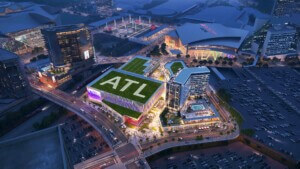Over the last few years, the areas around L.A. Live and the nearby Los Angeles Convention Center in Downtown Los Angeles’s South Park neighborhood have been undergoing a development boom, with mid- to high-end condominium and apartment complexes sprouting up at a steady clip. However, a new crop of projects currently either under construction or in the entitlement stages of development—dubbed Metropolis, 1020 Figueroa, Circa, and Oceanwide Plaza by developers—signal an infusion of upscale amenities headed for the area, all connected to the financial core and the rest of the city by a growing transit system, including the Long Beach–bound Blue Line and Santa Monica–bound Expo Line.
Three of the four projects mentioned above—1020 Figueroa, Circa, and Oceanwide Plaza—are to be located on the blocks directly across the street from the StaplesCenter, with the Metropolis development located a block northwest. Through their sheer density and size, they will bring a sorely missing street culture to an area that is roaring back to life.
But what will greet those pedestrians when they step off the trains and onto the streets? Walls of LED screens.
That’s because each project features large expanses of LED ribbon walls wrapping street-level commercial and leisure programs. And, to varying degrees, these ribbon walls are being programmed with art content in an effort to bring a new form of artistic expression to the street.
The Metropolis project, consisting of a multiphase, multi-tower hotel and apartment complex on a 6.33-acre site, is currently under construction, with the first phase of the project due to finish at the end of 2016. Eventually, the $1 billion-plus development will consist of four towers: Tower I will be 38 stories tall and contain 308 condominiums; Tower II will be 18 stories tall and contain a 350-room hotel; Tower III will be 40 stories tall and contain 514 condominiums; and Tower IV will be 56 stories tall and contain 736 condominiums. This project, designed by Gensler, is much further along in the construction process than the others and, as such, its arts program is starting to come into sharper focus.
The Metropolis project, like the others mentioned here, is subject to Section 22.118 of the City of Los Angeles Administrative Code, “Arts Development Fee Credits” (ADF) provision that requires commercial projects valued at $500,000 or more to pay a fee either based on the square footage of the building or equal to one percent of the project’s Department of Building and Safety permit valuation—whichever is lower—into a fund used to increase access to public art citywide. The ADF fund is administered by the city’s Department of Cultural Affairs, an arm of the city government that maintains a trust fund organized by project address to be used to fund arts initiatives at required sites, as necessary. This “one percent for the arts” approach is common in many California municipalities and is being stretched by this collection of projects to incorporate potentially new definitions of what public art might be in the city.
For Metropolis, arts consultants Isenberg & Associates partnered with project management firm DG Hunt & Associates to find suitable artists for the project. After a lengthy selection process, a team made up of digital media artists Refik Anadol and Susan Narduli was selected for the project. Their work Convergence, a 100- by 20-foot LED wall installation, will be unveiled in January of 2017 as construction on phase one wraps up, creating, the developers hope, an opportunity to introduce the project to the city and local community. Anadol and Narduli describe Convergence as “a generative construct fuelled by data and informed by aesthetics,” a synergy of Anadol’s digitally focused art practice and Narduli’s narrative-infused artwork. The duo wants the artwork—located in a plaza facing Francisco Street on the site’s eastern edge—to “create a lively public space by giving urban activities a new experiential dimension.” They plan to do this by fusing the “real-time demographic, astronomical, oceanographic, tectonic, and climate data streams, as well as social media posts, traffic, and news feeds into a constantly shifting cinematic narrative of Los Angeles.” The project was developed hand-in-hand with the architects as part of the overall design process, and is being deployed as an integrated architectural component of Metropolis.
According to the team’s statement, “Convergence explores new ways of storytelling through an intelligent platform that both expresses and responds to the spirit of the city in a seamless fusion of digital content, public space, and urban life.” The work will be available in situ for pedestrians to experience as part of the new sports and entertainment promenade the developers behind Metropolis hope to extend from L.A. Live to the upper reaches of the financial district. It will be available online, as well as via a mobile-device-friendly website accompanied by real-time audio. Experiencing the work in person will generate changes to the physical manifestation of the art, as the attendant data resulting from proximity, interaction, and occupation become woven into a living digital display.
It’s unclear what pedestrians can expect from the arts programs developed for the other three projects, but if Anadol and Narduli’s Convergence is a guide, expect more lights, more data, and perhaps most importantly, a closer relationship among architecture, digital art, and the public realm.










